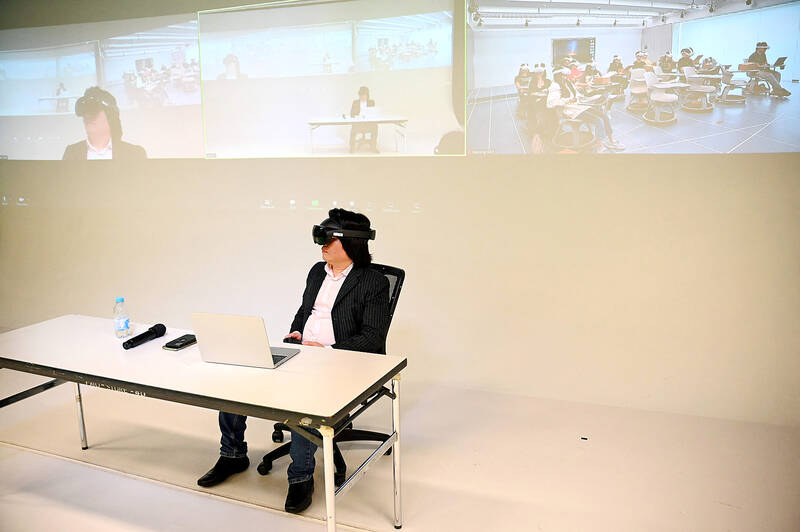Using virtual-reality (VR) headsets, students at a Hong Kong university travel to a pavilion above the clouds to watch an artificial intelligence (AI)-generated Albert Einstein explain game theory.
The students are part of a course at the Hong Kong University of Science and Technology (HKUST) that is testing the use of “AI lecturers” as the AI revolution hits campuses around the world.
The mass availability of tools such as ChatGPT has sparked optimism about new leaps in productivity and teaching, but also fears over cheating, plagiarism and the replacement of human instructors.

Photo: AFP
Pan Hui (許彬), a professor of computer science who is leading the university’s AI project, is not worried about being replaced by the tech and believes it can actually help ease what he described as a global shortage of teachers.
“AI teachers can bring in diversity, bring in an interesting aspect, and even immersive storytelling,” Hui said.
In his “Social Media for Creatives” course, AI-generated instructors teach 30 postgraduate students about immersive technologies and the impact of digital platforms.
These instructors are generated after presentation slides are fed into a program. The looks, voices and gestures of the avatars can be customized, and they can be displayed on a screen or VR headsets.
This is mixed with in-person teaching by Hui, who said the system frees human lecturers from the “more tedious” parts of their job.
For student Lerry Yang, whose doctoral research focuses on the metaverse, the advantage of AI lecturers was in the ability to tailor them to individual preferences and boost learning.
If the AI teacher “makes me feel more mentally receptive, or if it feels approachable and friendly, that erases the feeling of distance between me and the professor,” she said.
Educators around the world are grappling with the growing use of generative AI, from trying to reliably detect plagiarism to setting the boundaries for the use of such tools.
While initially hesitant, most Hong Kong universities last year allowed students to use AI to degrees that vary from course to course.
At HKUST, Hui is testing avatars with different genders and ethnic backgrounds, including the likenesses of renowned academic figures such as Albert Einstein and the economist John Nash.
“So far, the most popular type of lecturers are young, beautiful ladies,” Hui said.
An experiment with Japanese anime characters split opinion, said Christie Pang, a doctoral student working with Hui on the project.
“Those who liked it really loved it, but some students felt they couldn’t trust what [the lecturer] said,” she said.
There could be a future where AI teachers surpass humans in terms of trustworthiness, Hui said, though he said he preferred a mix of the two.
“We, as university teachers, will better take care of our students in, for example, their emotional intelligence, creativity and critical thinking,” he said.
For now, despite the wow factor for students, the technology is far from the level where it could pose a serious threat to human teachers.
It cannot interact with students or answer questions and like all AI-powered content generators, it can offer false, even bizarre answers — sometimes called “hallucinations.”
In a survey of more than 400 students last year, University of Hong Kong professor Cecilia Chan (陳嘉玉) found that respondents preferred humans over digital avatars.
Students “still prefer to talk to a real person, because a real teacher would provide their own experience, feedback and empathy,” said Chan, who researches the intersection of AI and education.
“Would you prefer to hear from a computer ‘Well done’?” she asked.
That said, students are already using AI tools to help them learn, Chan added.
“Everybody’s doing it,” she said.
At HKUST, Yang agreed: “You just can’t go against the advancement of this technology.”

STEPPING UP: Diminished US polar science presence mean opportunities for the UK and other countries, although China or Russia might also fill that gap, a researcher said The UK’s flagship polar research vessel is to head to Antarctica next week to help advance dozens of climate change-linked science projects, as Western nations spearhead studies there while the US withdraws. The RRS Sir David Attenborough, a state-of-the-art ship named after the renowned British naturalist, would aid research on everything from “hunting underwater tsunamis” to tracking glacier melt and whale populations. Operated by the British Antarctic Survey (BAS), the country’s polar research institute, the 15,000-tonne icebreaker — boasting a helipad, and various laboratories and gadgetry — is pivotal to the UK’s efforts to assess climate change’s impact there. “The saying goes

Police in China detained dozens of pastors of one of its largest underground churches over the weekend, a church spokesperson and relatives said, in the biggest crackdown on Christians since 2018. The detentions, which come amid renewed China-US tensions after Beijing dramatically expanded rare earth export controls last week, drew condemnation from US Secretary of State Marco Rubio, who on Sunday called for the immediate release of the pastors. Pastor Jin Mingri (金明日), founder of Zion Church, an unofficial “house church” not sanctioned by the Chinese government, was detained at his home in the southern city of Beihai on Friday evening, said

Floods on Sunday trapped people in vehicles and homes in Spain as torrential rain drenched the northeastern Catalonia region, a day after downpours unleashed travel chaos on the Mediterranean island of Ibiza. Local media shared videos of roaring torrents of brown water tearing through streets and submerging vehicles. National weather agency AEMET decreed the highest red alert in the province of Tarragona, warning of 180mm of rain in 12 hours in the Ebro River delta. Catalan fire service spokesman Oriol Corbella told reporters people had been caught by surprise, with people trapped “inside vehicles, in buildings, on ground floors.” Santa Barbara Mayor Josep Lluis

TICKING CLOCK: A path to a budget agreement was still possible, the president’s office said, as a debate on reversing an increase of the pension age carries on French President Emmanuel Macron yesterday was racing to find a new prime minister within a two-day deadline after the resignation of outgoing French Prime Minister Sebastien Lecornu tipped the country deeper into political crisis. The presidency late on Wednesday said that Macron would name a new prime minister within 48 hours, indicating that the appointment would come by this evening at the latest. Lecornu told French television in an interview that he expected a new prime minister to be named — rather than early legislative elections or Macron’s resignation — to resolve the crisis. The developments were the latest twists in three tumultuous